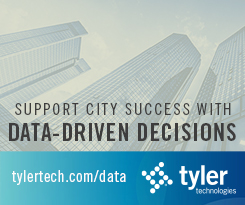
Photo: Khwanchai Phanthong | Dreamstime.com
Five ways data is helping local governments maximise federal funding
11 January 2023
Through funding from the American Rescue Plan Act (ARPA), the Infrastructure Investment and Jobs Act (IIJA) and the Inflation Reduction Act (IRA), US cities have an unprecedented opportunity to make long-needed upgrades that provide lasting benefits for residents.

The scale of the investments requires cities to be transparent about how they are allocating and spending the money and the outcomes it’s delivering.
Data is fundamental to helping local governments achieve this, says Elliot Flautt, Director of Solutions Engineering at Tyler Technologies. He notes that many cities and counties are leveraging data infrastructure and capabilities that they developed during the pandemic to underpin their long-term recovery.
Flautt outlined some of the key ways that data can support the entire funding lifecycle.
Application and allocation
Some of the available funding is being distributed via competitive grants, meaning cities will need to provide strong evidence of the need for the money and the benefits it will deliver. Data is key to identifying priority projects and creating compelling grant proposals.
The pandemic brought a heightened focus on equity and cities are committing to ensure services benefit all residents. In addition, the federal funds that cities are now receiving are not recurring, meaning local governments must plan carefully to get the biggest bang for their bucks.
Chattanooga in Tennessee, for example, has used third-party mobility data and open-source information alongside its own data to monitor economic recovery and ensure funding is being spent in areas that are most in need.
“It’s important that spending decisions are data-driven,” said Flautt.
“Transparency is very important in showing how you’re making decisions about the money because people are always going to have questions around why it’s being spent in a certain way,” he commented.
Governments can also use data to better target individuals who are eligible for support.
Early in the pandemic, Ramsey County offered rent and mortgage assistance to residents who lost income due to COVID-19, funded through the CARES Act.
Flautt said: “We were able to create a dashboard bringing in a variety of different data feeds from federal government, like the CDC Social Vulnerability Index, as well as county-owned data sources like property and tax records to better target individuals who would be candidates for the support.”
This enabled the county to engage in more proactive outreach with residents.
Resident engagement
Cities are working to ensure residents feel informed about how money is being used and the progress on projects.
“We are seeing a lot of dashboards being set up by our clients to show exactly how these funds are being spent. Following the COVID crisis, residents are now used to seeing data dashboards and understanding what the data elements mean and how to interpret them,” Flautt said.
Useability is as crucial as access, though.
Pierce County in Washington used Tyler’s Enterprise Data Platform, which it has had in place since 2018, to track its CARES Act allocation of US$158 million. The county then built a data tracker for its US$176 million American Rescue Plan Act allocation.
During a webinar held by the Pandemic Response Accountability Committee last year, Julie Demuth, Assistant Director of Budget and Performance for Pierce County, said: “How we communicate data is essential. Communication is probably even more important than the data itself. You can put a ton of data out there and make it available to the public but if it’s not consumable or understandable, it really defeats the purpose.”
Federal reporting
Some federal funding obliges recipients to complete financial, performance and compliance reporting. With the right tools, local governments can go beyond legal requirements to provide more robust feedback.
Flautt gives the example of Fulton County which built a rental relief dashboard and used Tyler’s platform as the reporting layer back to the US Department of the Treasury, which had provided funding.
While the reporting requirements are sometimes as basic as a Word or PDF document, Flautt said: “Fulton County is able to make the data much more contextualised by incorporating mapping and other elements to show what they’re doing with the funds they received from the Treasury.”
The latest systems can also automate some of this work. This is important as the federal government has emphasised the need for machine-readable, standardised data.
“APIs mean the federal government can receive data at a regular scheduled cadence without cities and counties having to devote staff time to assembling these feeds,” said Flautt. “Staff can focus on higher value service delivery and projects that are going to be more impactful.”
Outcomes
Many cities and counties are now developing Key Performance Indicators (KPIs) to measure the effectiveness of projects launched with federal funding.
Flautt said: “That’s where data really shines by being able to give residents a clearer view of not just the descriptive statistics around total dollars spent, but also the types of outputs that are materialising and the outcomes that can be expected from these funds.”
KPIs can also help cities plan more effectively. Flautt cites the example of the year-over-year change in total dollars that have been spent within a city, which can have a direct impact on the city’s tax base.
“They can better predict their budget as they’re starting to build the next budgeting cycle,” said Flautt.
Benchmarking and contextualisation
Local governments are using external data, such as from the federal government and third-party sources, to get a much richer picture of recovery and also to benchmark themselves against other cities.
This includes macroeconomic data, mobility, economic and property data, small business information and more.
“During the pandemic, Tyler focused heavily on setting up long-term partnerships with third-party data providers to be able to offer that to our clients,” said Flautt.
The state of New Jersey, for example, is using Tyler’s Economic Intelligence solution to understand trends.
“The pandemic has significantly impacted small business revenue and consumer spending habits, and we needed a tool that would help us easily analyse how these metrics have impacted our state’s overall economic picture,” said Poonam Soans, Chief Data Officer for the state of New Jersey.
“The Economic Intelligence solution gives our leadership a single, comprehensive view of the critical third-party data that is central to our economic recovery and understanding the ways in which New Jersey’s recovery from COVID-19 progresses.”
You can’t manage what you don’t measure – establishing the right metrics and breaking data out of silos is key. Learn more about how Tyler Technologies can help your city.












